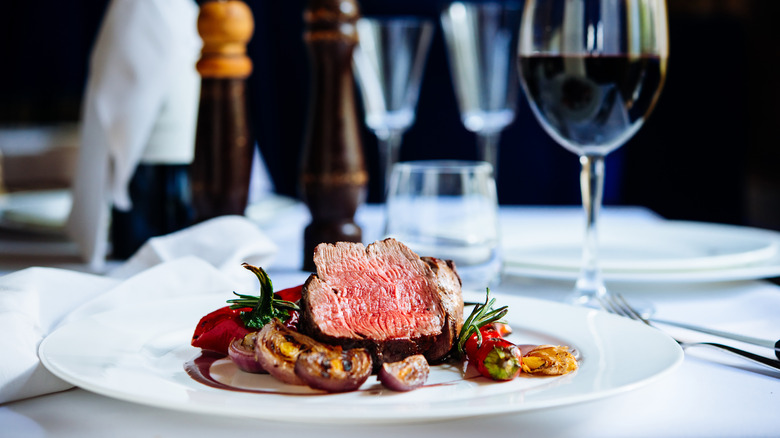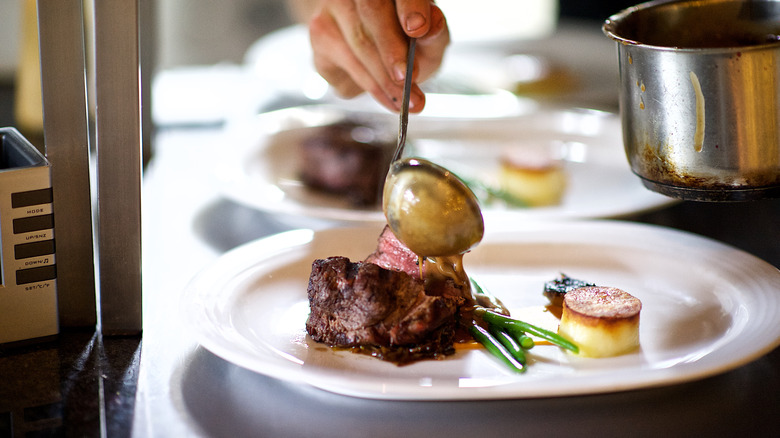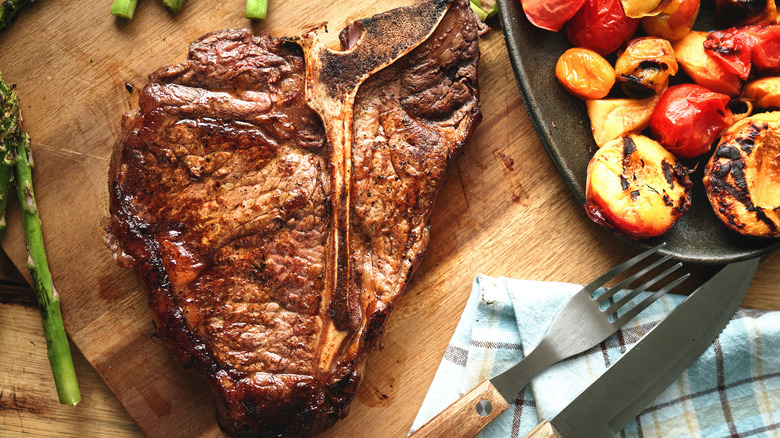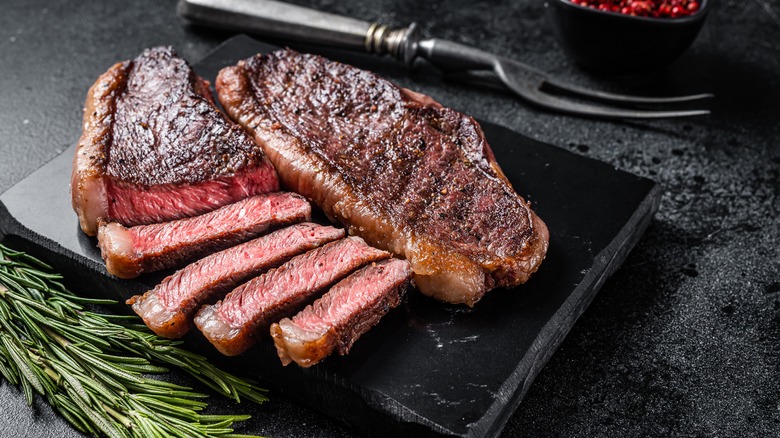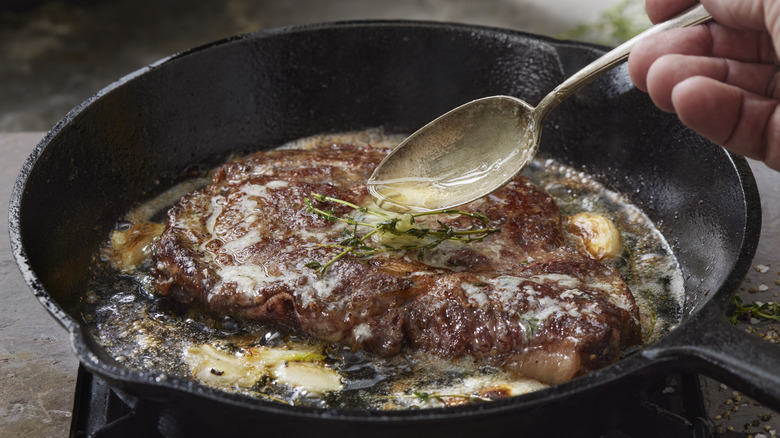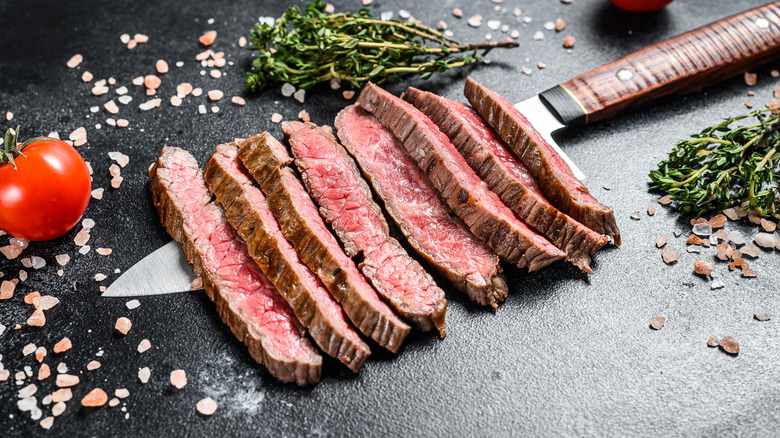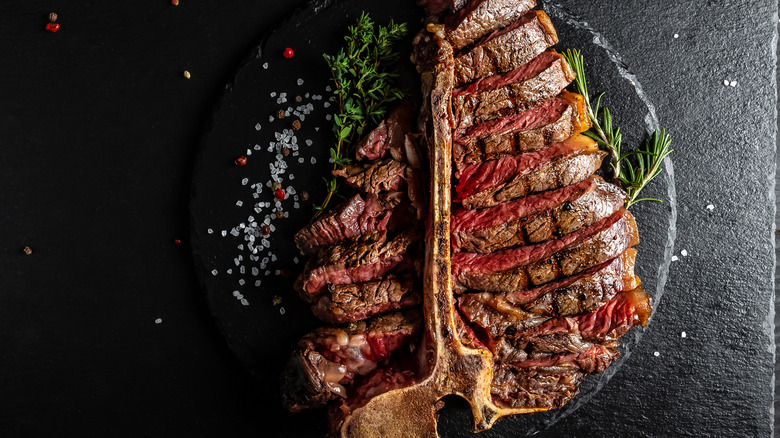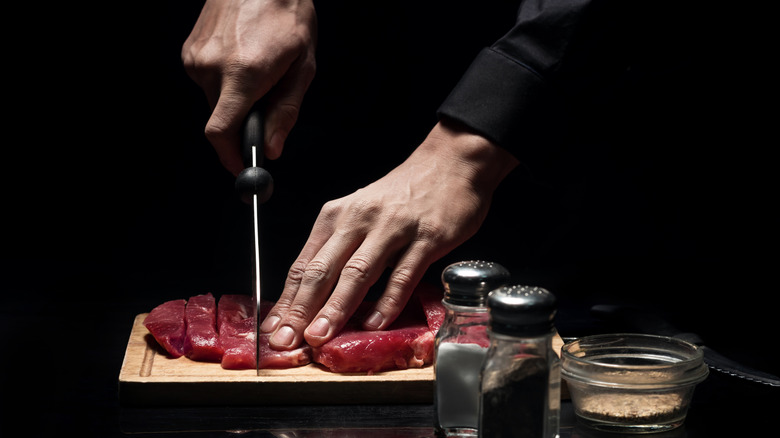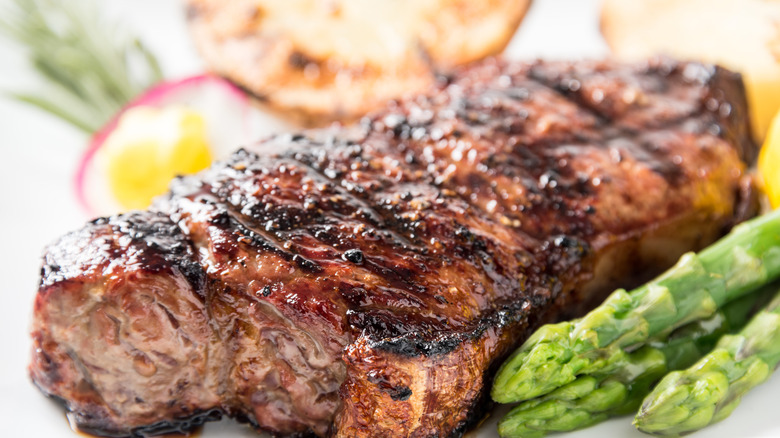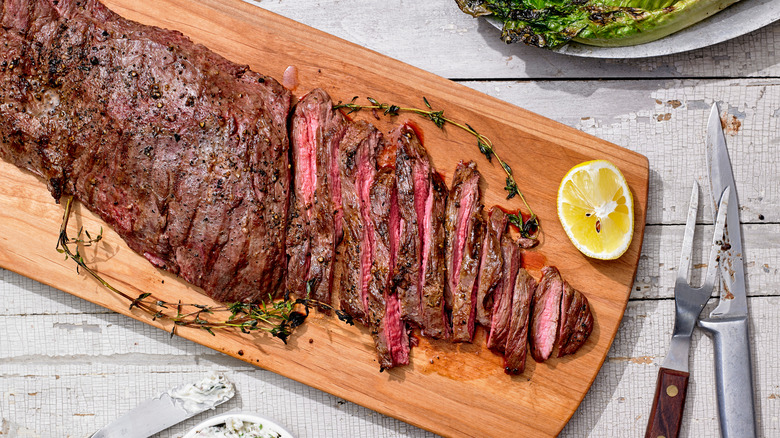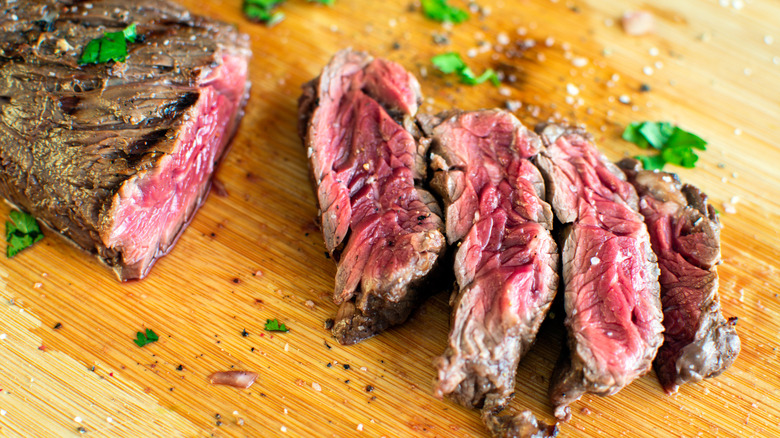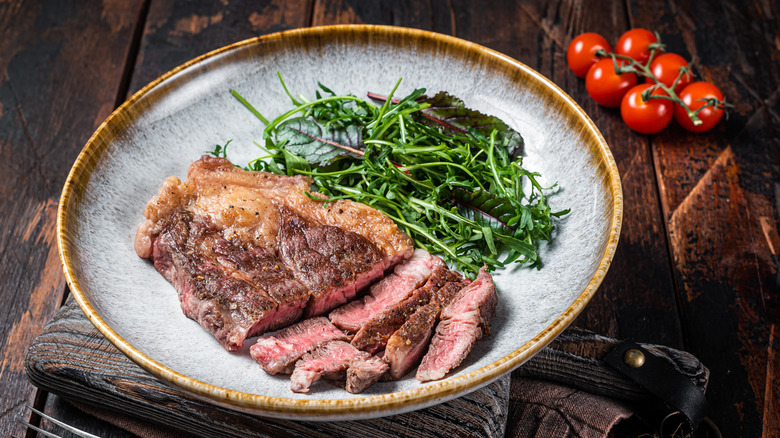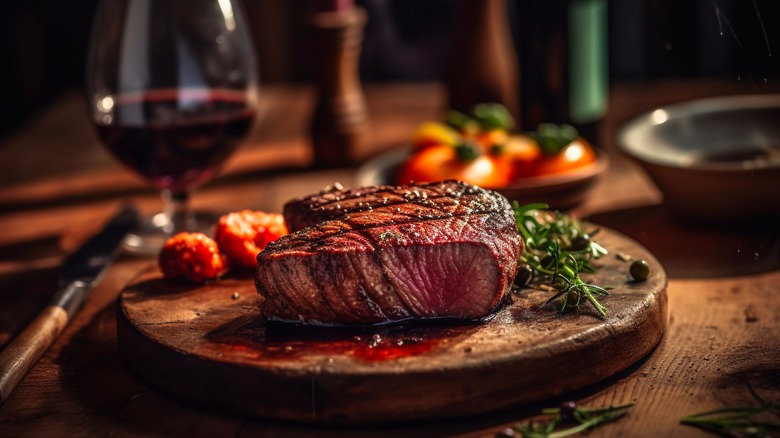6 Cuts Of Steak You Should Never Order Rare And 5 You Should
Those who love nothing more than a good steak, whether prepared at home or ordered at a favorite steakhouse, can develop pretty staunch opinions regarding how a steak should be cooked. Some swear up and down that the rarer, the better, while others fall into a nice middle ground, and yet some say that they can't stomach even a little pink.
We're not here to argue with you about how you might take your steak. However, depending on how you like your steak cooked, you may want to order certain cuts over others. According to the experts — including a few chefs who've cooked plenty of steaks in their day and gave us their insights (more on their expertise at the end of this article) — certain cuts fare better when cooked rare, while others need to be cooked longer. This is due to a variety of factors, including cut thickness, fattiness, and others. Need to know more so you're equipped during your next steakhouse outing (or when you're buying a steak to cook at home)? Here are six cuts of steak you should never order rare and five that you should.
Do Order Rare: Filet Mignon
If you want to spring for a "nice" steak at a restaurant, chances are likely that you'll order the filet mignon. These relatively small cuts are known for their extreme tenderness and are often paired with a variety of rich sauces and similar accompaniments for a decadent meal you're sure to remember. Filet mignons are part of the tenderloin portion of the animal, and are on the lean side, with less fat than some other cuts.
Because of this leanness and lesser marbling, filet mignons are one of the cuts that chefs say you should always order rare. According to Chef Mike Tsarnas, at Gabriella's Italian Steakhouse in Red Bank, New Jersey, "It's important to note the marbling when ordering steak. If always ordering rare, I suggest you stick with leaner cuts — filet mignon, sirloin, etc. These cuts benefit from a shorter cooking time due to their natural tenderness and lack of marbling." Additionally, if you're cooking a filet mignon at home and want to get that perfect rare level of doneness, Chef Giancarlo Borletti of New York City's BSTRO38, says a filet mignon is very easy to cook rare.
Do Not Order Rare: T-Bone
A T-bone is an easily recognizable cut of steak thanks to its characteristic T-shaped bone running across the steak's top and down the middle. The T-bone is sourced from the short loin and it is actually two separate steaks that are connected by the bone. On either side of the T, you'll find two steaks that, when split and removed, are then considered a New York Strip and a filet mignon. A T-bone must be at least half an inch thick at its widest in order to be considered a T-bone by the U.S. Department of Agriculture.
So, why shouldn't you order a T-bone rare? Chef Tsarnas noted that the larger amount of fat in a T-bone means that it needs a longer cooking time. He told us, "I would avoid ordering cuts [rare] that are known to be well-marbled like a T-bone or ribeye. Because they are higher in fat, in order to get a rich flavor, they would need to be cooked for a longer time."
Do Order Rare: Sirloin
Just like filet mignon, sirloin is a leaner cut of meat. It's sourced from the rear and is considered a cut that's versatile, great for grilling, and flavorful. You may also be able to find it for a bit of a better price than you might be able to find other, leaner cuts. In addition to being used for steak (the top sirloin), the sirloin area also contains meat that's typically used for ground beef and other affordable uses. So, if you're looking for a great steak to order rare (and one that's going to be more affordable than that fancier filet mignon), then look to the top sirloin.
Chef Borletti said, "Top sirloin is definitely an option to order rare, simply because it can get a little tough if it's overcooked." A sirloin steak can require as little as under two minutes of cooking time per side.
Do Not Order Rare: Ribeye
The ribeye comes from — where else? — the ribs of the animal. A ribeye is known for its fatty marbling and lots of intramuscular fat, and can be either bone-in or boneless. Prime rib and ribeye steaks are very similar, but prime rib is a larger cut and, thus, the two are cooked very differently. Ribeye steaks are a favorite at prominent steakhouses around the world (in fact, it's even a favorite for several Michelin-starred chefs), but if you decide to order a ribeye the next time you're at a steakhouse, don't make the mistake of ordering it rare.
"A cut like ribeye needs to be at least medium rare or medium in order to crisp all that delicious fat, and also needs time to break the fat," said Chef Borletti. In general, when cooking or ordering a steak, keep in mind that the fattier the cut the longer it likely needs to cook for the best flavor and texture. This means you'll need to order your steak at a greater level of doneness.
Do Order Rare: Flat iron
A flat iron steak is a small-ish, flat, rectangular steak that comes from the animal's shoulder area. While the flat iron steak is known to be tender and has some nice marbling, it's still considered to be a cut that you won't want to cook for very long. Many recipes call for it to be cooked via quick-cooking methods, so it's one that chefs feel should be ordered rare.
If you're attempting to cook a flat iron steak at home, many suggest grilling or pan-searing it first, then moving it to indirect heat or to your oven where it can gently come up to the temperature you're after. On that note, Chef Tsarnas advised, when asked if he had any particular tips for home cooks and cooking their steaks regardless of cut to the perfect temperature, "A meat thermometer is essential when cooking a steak to the perfect temp! It'll be very useful when ensuring accuracy."
Do Not Order Rare: Porterhouse
A porterhouse steak is often one of the largest steaks you can order at a steakhouse, and is a high-end cut that you could even share on a date. However, if you want to impress, don't order that shared date steak rare. Chef Borletti mentioned that porterhouse steaks are right next to ribeye steaks in their need for a longer cooking time. This especially makes sense when you realize that a porterhouse is very similar in shape and style to a T-bone, another steak that Borletti mentioned is difficult to cook rare.
In fact, the T-bone and porterhouse steaks come from the same area of the animal. They both have that T-shaped bone running along the top and the center of the steak. They also have two different steaks on each side of the bone, the tenderloin on one side and the strip steak on the other side. The main difference between the two? Thickness. A porterhouse steak must be cut so that its tenderloin side reaches a thickness of at least 1.25 inches at its widest point, according to the U.S. Department of Agriculture.
Do Order Rare: Paleron
If there's any cut of steak on this list that might not be all that familiar to you then it's going to be the paleron. Paleron is a steak of French origin, and it comes from the shoulder of the animal. It's pretty similar to a flat iron steak, but there are some key differences. The paleron has some untrimmed bits that a flat iron doesn't have, and the meat's grain is slightly different. However, much like a flat iron steak, paleron is pretty affordable as far as cuts of steak go, and it's best enjoyed rare to medium rare according to chefs.
While not as common as your T-bone or your filet mignon, if you can find paleron served near you, it's worth trying. As Anthony Bourdain wrote in a 2000 article for The New York Times, paleron is one of the "odd cuts ... few actually available to Americans" and that "yields excellent steaks for searing and grilling."
Do Not Order Rare: Strip Steaks
A strip steak, sometimes just called a New York strip or a top loin, comes from close to the middle part of the animal. It's situated between the ribeye and the sirloin. It's connected to the T-bone steaks and the porterhouse steaks. The tender, fatty steak can be cooked close to rare, but not quite. Chefs recommend that you cook this steak to around medium-rare instead, which is long enough to break down the fatty marbling, and to easily cook the steak's thicker girth, but without overcooking it.
Since this is a widely available cut of steak, you've likely tried your hand at making it at home. If so, next time, try some of Chef Borletti's top steak-cooking tips. He said, "Take your steak out of the fridge and let sit for at least 20 minutes; you don't want to cook a cold steak. Pat dry your steak before seasoning. Make sure you seasoned well with salt and pepper. Use a cast iron if you have one [with] good oil, and make sure your pan is hot ... Finish it with a good baste of butter, thyme, rosemary, garlic, bay leaves ... It really up the flavors. And, right before you serve, finish your steak with a good quality extra virgin olive oil and finishing salt. Salt of Mara's from Peru [is] my favorite."
Do Order Rare: Skirt Steak
A skirt steak comes from the "skirt" part of the animal — think the very underside of the cow's belly. Skirt steak is known for being long, lean, thin, and tough if you don't cook it correctly. In fact, if you cook it too long, it's going to be exceptionally tough. For that reason, cook this steak only to rare. The aim is to cook on exceptionally high heat as quickly as possible to brown the steak on the outside, without toughening up the meat fibers on the inside.
However, cooking this steak to rare only, and cooking it fast and hot, aren't the only things you'll have to do to ensure that you don't run into a tough bite or two. You'll also want to be sure that you cut your skirt steak against the grain. This will help break down any tough fibers so the steak is easier and more enjoyable to eat. This is not a steak that you'll be leisurely eating with a baked potato in big, succulent chunks — a skirt steak is best enjoyed in long, narrow strips, such as on top of a salad, in a stir fry, or fajitas.
Do Not Order Rare: Hanger Steak
Hanger steak is very similar to skirt steak. Like a skirt steak, hanger steak comes from the underside of the animal, near the skirt steak. Also like a skirt steak, a hanger steak is relatively less expensive when compared to some other cuts of steak, and it is relatively narrow and flat. Where it differs is that it contains more fat and marbling, which is why you might prefer a skirt steak rare, while you might prefer a hanger steak medium rare instead. In fact, medium rare is what's recommended for a hanger steak.
Hanger steaks still need that high heat and a quick cooking process so as not to dry the steak out making it tough and chewy. You'll also want to cut a hanger steak against the grain to enhance its texture further. Because of this, hanger steaks are likewise a good choice for salads, tacos, and similar recipes that require sliced steak.
Do Not Order Rare: Chuck Steak
A chuck steak comes with many benefits. It's incredibly affordable, versatile, and can be cooked in many ways. Sourced from the animal's shoulder, it's a bit tougher than some of the more expensive cuts of meat, but with the right preparation — and being sure to cook the steak to just around medium rare or medium — you can achieve a tender, juicy, succulent steak on a budget.
When you're dining out, you might not see chuck steak on the menu. So, you might not get a chance to order it at all, let alone at any temperature above rare. In that case, if you find yourself at a loss for what to order and what doneness, Chef Tsarnas has a suggestion: "Make sure to describe exactly what you are looking for to your server, including any particular preferences. The server can then communicate with the professional cook. If you are not picky with your steak cuts, you can always ask the server which cuts the restaurant offers that will benefit the most from the level of done-ness you are looking for."
Methodology
For this article, we interviewed Chef Giancarlo Borletti of New York City's BSTRO38. Chef Borletti boasts more than 20 years of experience and has learned from top chefs and worked at Michelin-starred restaurants. We also interviewed Chef Mike Tsarnas of Gabriella's Italian Steakhouse in New Jersey. Chef Tsarnas provides a unique and extraordinary dining experience at Gabriella's, known for its premium steaks, fresh raw bar, and classic Italian dishes.
